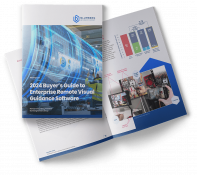Help Lightning Blog
Remote Assistance as a Field Service Differentiator

Learn something new with Dan Turner, Global Business Manager at Oxford Nanoanalysis, as he presents a webinar on the ways that his team uses remote assistance as a field service differentiator.
Dan speaks honestly about the ways that Help Lightning has adapted the manner in which Oxford Nanoanalysis brings value to their customers.
This webinar recap has been edited for clarity and length. You can watch a replay of the full webinar or view other remote assistance webinars.
New Types of Field Service Models
To begin, Dan provides a brief background of the service models that businesses have historically depended upon. Dan provides great insights into the flaws of outdated service models.
DT: The most common service model is what we call “break-fix.” The product’s there and it’s working. At a certain point, the customer works out that it’s not working. They call you up as an organization, and somebody goes in and fixes it. That’s really, really, low value to the customer. It’s very time consuming. It’s inefficient, the time between a product breaking and it being fixed could be weeks; it could be months.
Dan next explains how remote assistance is the future of field service as it has allowed business to switch from reactive customer support to proactive customer support.
DT: Reactive support is really the same thing as break-fix because there’s a failure event. The important thing with the failure event is that it is a model that relies on the customer detecting that something has failed. Something might not be operational long before it has failed. It may be giving the wrong results (depending on the product). It’s really not a good place. The sweet spot is getting proactive: Understanding what that machine is doing, having the tools and metrics to measure that, and getting to those customers quickly and efficiently.
AR’s Impact on Customer Support
Dan speaks on the groundbreaking features of Help Lightning’s augmented reality technology and the ways that it is changing how his tech support team can assist their customers.
DT: When you’re with a customer virtually in their environment, it’s highly efficient. Annotation is a really nice feature. Documents are useful; photos more so. You can show someone what something should look like. The real power of the technique is to actually have the tools and the objects to show someone. There’s a hierarchy of learning that says:
You talk; I listen.
You show; I see.
I do; I understand.
And this is what we’re doing with augmented reality. We’re actually getting the person that’s being helped to actually do what we’re showing them to do. We’re even showing them the tools to use and how to use them. You could never describe that in an email. It would be very hard to describe that on the phone. It’s just kind of instant when you’re using augmented reality.
Remote Assistance As A Field Service Differentiator During COVID-19
Dan details how Oxford adapted their methodologies after the global pandemic hit. As they were no longer able to make on-site service calls, they turned to Help Lightning to assist their customers.
DT: Up until that point, we had 60 service engineers that we did not know what we were going to do with. We didn’t know how long the pandemic would last. We honestly didn’t know if we’d be able to keep people employed. But I started to see the call volume bump up and up and up. So we were able to access our customers and give value to them without visiting them. And that’s really made the technology stick [at Oxford Nanoanalysis].
No Special Hardware, No App Download Required
Dan discusses that the beauty of the remote assistance field service software is that it includes no special hardware on the customer’s end.
DT: The beauty of it is that it works on Android, iOS, tablet, phone, smart phone, and PC…the whole beauty of it is that you don’t need to send anything. The whole beauty of it is that it’s in the moment. You’re interacting with the customer with the device that they have in their hand. The moment you say, “Great. We can do this, but we need to send you a piece of equipment,” you’re out of the game. There’s a time delay with that. We can call you now on your Android, on your iPhone, on your iPad.
Getting Teams to Adopt Remote Assistance Software
When asked if he’s had any trouble getting his team to adopt Help Lightning, Dan gives a thoughtful answer.
DT: Out of 60 service engineers, you’ll get a few that really get it and say, “Oh yeah, this is great. I’m going to use this all the time.” And then you get some that avoid it…You get what I call clear opinion leaders.
However, it’s about leading from the front. You get one or two people using it, then you get four. You get four, then you get eight.
And it grows and grows and grows. In the last year, we’ve done a thousand calls using it [Help Lightning].
Next Generation Customer Support
It is now possible for businesses to provide intimate customer support without having to travel onsite. Help Lightning’s AR-enabled technology allows technicians to see what customers see. They are now able to literally bring their hands onto the customer’s screen to demonstrate a solution to the problem.
Now, business can add value to their customers, not just using remote assistance as a filed service differentiator, but also being an expert teacher. There’s no more expensive travel for customer support. There’s no more endless phone calls where problems don’t get solved.
Request a free demo of Help Lightning today!












